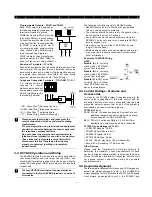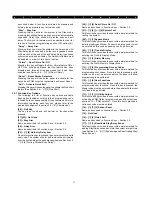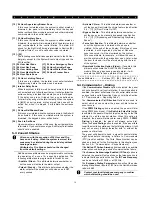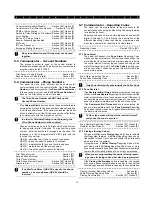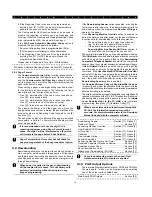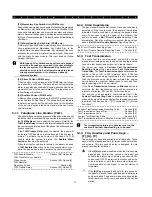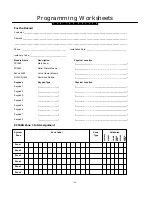
16
P R O G R A M D E S C R I P T I O N S
Communicator Enable/Disable ........... Section [60], Option [1]
Communicator Call Direction Options ....... Section [51] to [55]
DTMF or Pulse Dialing ........................ Section [60], Option [2]
Switch to Pulse Dialing on 5th attempt Section [60], Option [3]
Force Dialing ........................................ Section [82], Option [2]
Bell on FTC when Armed .................... Section [81], Option [5]
Answer Acknowledge Enabled
(ID Tone) ............................................... Section [82], Option [5]
ID Tone Frequency ............................... Section [82], Option [6]
European Dialing Parameter ............... Section [82], Option [1]
Busy tone detection and ID tone must not be used
together.
5.5 Communicator – Account Numbers
The account number is used by the central station to
distinguish between panels. There are two account numbers
programmable for the PC1580.
First Account Code (4 digits) ................................. Section [34]
Second Account Code (4 digits) ............................ Section [35]
5.6 Communicator – Phone Numbers
The panel can use three different phone numbers for
communicating with the central station. The
First Phone
Number
is the primary number, the
Second Phone Number
is the secondary number and the
Third Phone Number
will
back up the First phone number if enabled.
The Third Phone Number will NOT back up the
Second Phone Number.
If the
Alternate Dial
option is enabled, the panel will alternate
between the first and third phone numbers when attempting
to call the central station. If the option is disabled, the panel
will only attempt to call the Third phone number after failing
to communicate with the first phone number.
In order for Alternate Dialing to work properly, the
Third Phone Number must be enabled.
Phone numbers can be up to 32 digits which will allow you
to add special digits if required. To program the phone
number, enter the numbers 0 through 9 as required. The
following is a list of programmable HEX digits and the
function they perform:
HEX (B) - simulates the [
✱
] key on a touch tone phone
HEX (E) - forces the panel to pause for 2 seconds
HEX (C) - simulates the [#] key on a touch tone phone
HEX (F) - marks the end of the phone number
HEX (D) - forces the panel to search for dial tone
First Phone Number ............................................... Section [31]
Second Phone Number .......................................... Section [32]
Third Phone Number .............................................. Section [33]
Third Phone Number Enable .............. Section [60], Option [4]
Alternate Dial ........................................ Section [60], Option [5]
If no Dial Tone Detect (HEX D) is used in the phone
number, a 2-second pause (HEX E) should be
inserted.
5.7 Communicator – Reporting Codes
The panel can be programmed to report events to the
central station by sending the Reporting Code programmed
for a particular event.
Reporting codes can be one or two digits and can use HEX
digits (A through F). The following is a description of the
different Reporting Codes that can be programmed and
when the events will be reported to central station.
Reporting Codes ......................................... Section [36] to [46]
5.7.1 Zone Alarm
The panel will transmit the
Zone Alarm
Reporting Code
when a zone goes into alarm. 24 hour type zones will go into
alarm whether the panel is armed or disarmed and report to
the central station. All other types of zones will only go into
alarm if the panel is armed. The
Police Code
reporting code
will be sent after 2 zones have gone into alarm within the
same armed period.
Zone Alarm Reporting Codes ................................ Section [36]
Police Code Reporting Code ................................. Section [36]
Only Zone Alarms will count towards the Police Code
5.7.2 Zone Restoral
If the
Restoral on Bell Time-out
option is selected, the panel
will send the
Zone Restoral
Reporting Code for the zone if the
alarm output times out
and
the zone is secured. If the zone is
not secured when the alarm output times out, the panel will
send the restoral immediately once the zone is secured.
If the
Restoral on Bell Time-out
option is not selected, the
panel will immediately send the
Zone Restoral
Reporting
Code when the zone is secured, regardless of whether or not
the alarm output is active.
24 Hour type zones will report the restoral immedi-
ately once the zone is secured.
Zone Restoral Reporting Codes ......... Section [37], Option [6]
Restoral on Bell Timeout ..................... Section [60], Option [6]
5.7.3 Closings (Arming Codes)
The panel will transmit a
Closing
Reporting Code to indicate
that the system is armed. A different Reporting Code can be
transmitted for each User Code and Master Code to identify
who has armed the system.
If programmed, a
Partial Closing
Reporting Code will be
sent along with the
Closing
Reporting Code if one or more
zones were manually bypassed when the system was armed
to warn the monitoring station of a security compromise.
When you are programming the partial closing report-
ing code, all closing codes must also be programmed.
If the
Closing Confirmation
option is enabled, the keypad
will sound a series of eight beeps to confirm to the user that
the closing code was sent and received by the central station.
Closing (Arming) Reporting Codes ....................... Section [41]
Partial Closing Reporting Code ............................. Section [41]
Closing Confirmation ........................... Section [61], Option [1]



